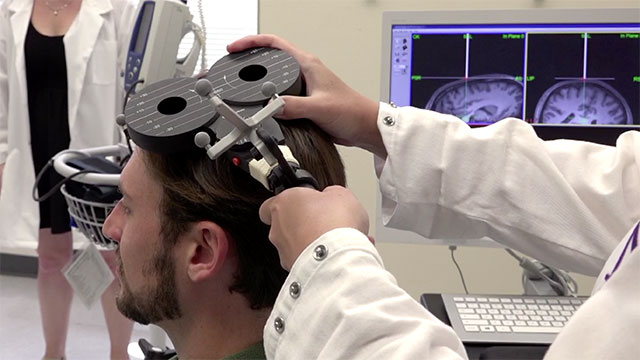You might remember you ate cereal for breakfast but forget the color of the bowl. Or recall watching your partner put the milk away but can’t remember on which shelf.
A new Northwestern Medicine study improved memory of complex, realistic events similar to these by applying transcranial magnetic stimulation (TMS) to the brain network responsible for memory. The authors then had participants watch videos of realistic activities to measure how memory works during everyday tasks.
The study found that brain stimulation led to higher quality reinstatement of memories in the brain. Reinstatement is when the brain replays or relives an original event, said lead author Melissa Hebscher, a postdoctoral fellow at Northwestern University Feinberg School of Medicine.
Following stimulation, a person’s brain activity while remembering a video more closely resembled their brain activity when they watched that same video for the first time.
“This is why remembering can sometimes feel like ‘mental time travel,’” Hebscher said. “Our findings show that stimulation enhances memory replay in the brain and improves accuracy. These findings have implications for the development of safe and effective ways to improve real-world memory.”
The study was conducted on healthy young adults in a controlled laboratory setting. These methods, however, also could eventually be used to improve memory in individuals with memory disorders due to brain damage or neurological disorders, Hebscher said.
The study was published Feb. 4 in the journal Current Biology.
A new approach to studying memory: Incorporating video

The study authors used TMS with the goal of altering brain activity and memory for realistic events. Immediately following stimulation, subjects performed a memory task while having their brains scanned using functional magnetic resonance imaging (fMRI).
Instead of showing study participants pictures or lists of words – typical practices in laboratory tests that analyze memory – participants in this study watched videos of everyday activities such as such as someone folding laundry or taking out the garbage.
“Our study used video clips that more closely replicate how memory works on a day-to-day basis,” Hebscher said.
Following stimulation, study participants more accurately answered questions about the content of the video clips, such as identifying the shirt color an actor was wearing or the presence of a tree in the background.
How the study worked

The study authors used a brain imaging technique called multi-voxel pattern analysis to compare patterns of brain activity when subjects were watching a video to brain activity when subjects were remembering that same video. The scientists measured the effect of stimulation by comparing memory and brain activity following stimulation of the memory network to the same measures following stimulation of a control brain region that does not belong to the memory network.
During the memory test, subjects watched a large set of video clips and later remembered them and answered true/false questions about the content of the videos. The researchers found that memory network stimulation improved the number of questions that subjects answered correctly. It also increased reinstatement of videos in brain regions associated with visual processing.
“Follow-up studies will work to gather more reliable measures of the brain network responsible for memory in healthy subjects as well as in patients with memory disorders,” Hebscher said. “Having a more reliable measurement of this network will help us more easily identify reinstatement in the brain and may help improve the effectiveness of stimulation for enhancing memory.”
The senior author is Joel Voss, associate professor of medical social sciences, neurology and psychiatry and behavioral sciences at Feinberg. Other Northwestern authors include Thorsten Kahnt, assistant professor of neurology at Feinberg, and postdoctoral fellow James E. Kragel.


